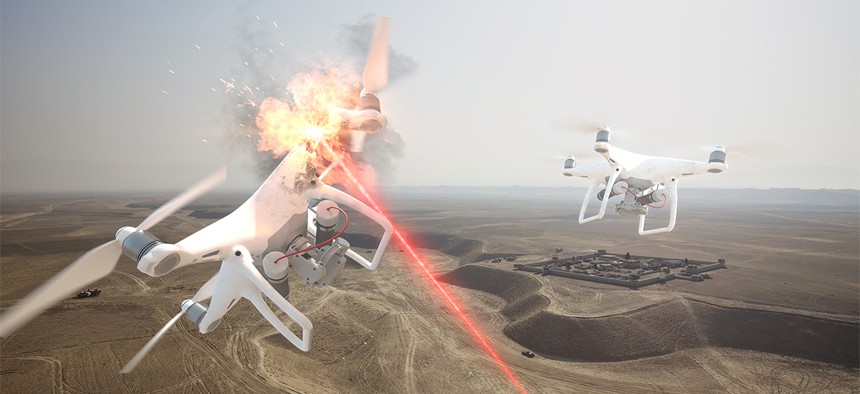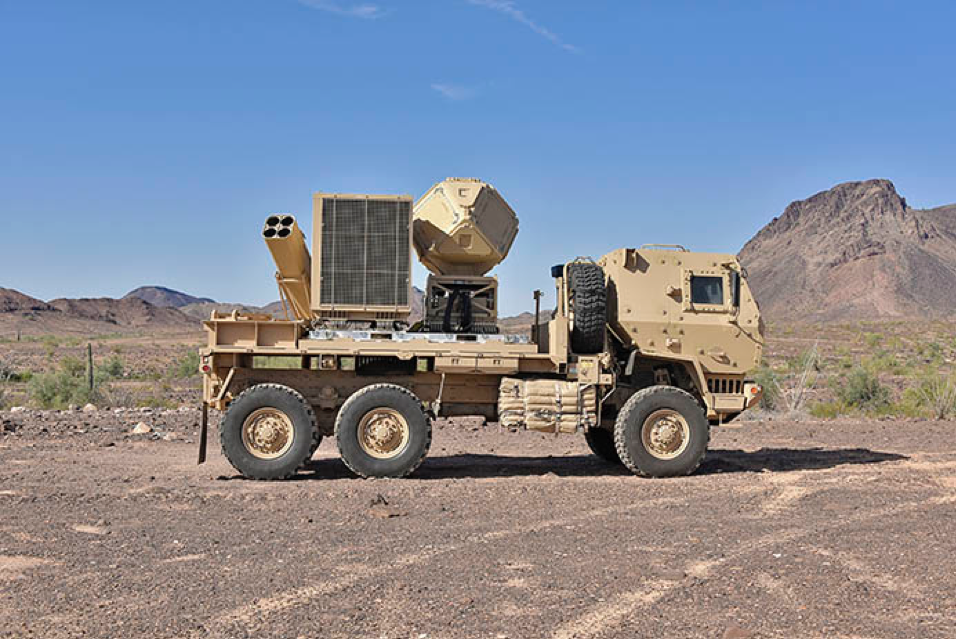sponsor content What's this?

What to do about drones: The tech that will protect airports, stadiums and military bases
What’s the best public defense against drones? Learn more about the smartest use of technology to protect airports, stadiums and military bases against rogue drone attacks.
Presented by
Raytheon

They're a problem hanging over everyone's head.
They hover over sports stadiums and have crashed into the stands. They shut down airports. They spy on soldiers and can drop crude IEDs with precision.
Cheap, capable quadcopter drones mean everyone from civilian air traffic controllers to front-line military commanders need new and specialized technologies to meet the threat.
“This is very fast-moving from a technology standpoint,” said Todd Probert, a Raytheon vice president who oversees the company’s work in space, intelligence and command and control. “Too much of the environment is reacting to it. They need someone to come in and system-engineer a solution to whatever their problem is.”
Sometimes the answer to rogue drones is as simple as knowing they’re there, and sometimes it is complex, like a coordinated counterattack with lasers, radio waves, small drones and even missiles. It all depends on who is responding – and what they’re protecting.
THE STADIUM
Pick your sport, pick your spot. Baseball in Boston. Football in California. Soccer in Scotland.
When drones buzz sports stadiums, authorities have to act fast to assess and address the threat without endangering the crowd. That starts with radars and electro-optical sensors that can pick out slow, low-flying objects, even in the clutter of an urban environment.
“Being able to detect those as far out as possible, as quickly as possible and in as much detail as possible, is paramount,” said Cliff Johnson, a director for business development in tactical radars at Raytheon.

The versatile KuRFS radar uses active electronically scanned array technology to track airborne objects including unmanned aerial systems.
With a good counter-drone radar, authorities can buy themselves time and track even the most haphazard drone flight pattern. But that leaves the question of how to deal with it.
At a stadium, shooting a drone down – or smacking it with what military officials call a "kinetic effector" – is simply too risky; you don't want to send shrapnel flying into the stands, and even a lightweight drone plummeting to the ground can injure people.
“You want one of those non-kinetic effectors that will just have it come down to Earth in one piece, or confuse it so it goes off, and not just have it go boom,” Johnson said.
In those cases, authorities can take advantage of drones’ dependency on radio frequencies. Jamming a drone’s GPS or Wi-Fi signal can confuse it and trip a mechanism that forces it to land or retreat.
THE AIRPORT
Airport radars are really good at looking for planes. But planes and drones aren’t the same thing.
While you can’t beat a traditional air traffic control radar for tracking a jetliner many miles away, the problem is that the drones causing the most trouble – those classified by the U.S. Department of Defense as class 1 and class 2 – fly below 3,500 feet. That’s far lower than air traffic control radars typically look.
“A class 1 or class 2 unmanned aerial system that is flying extremely low? These radars are looking so far out they wouldn’t even see that UAS approaching the airfield,” Johnson said.
Instead, he said, what airports need is a radar with a low gaze and a fast update rate. While a few seconds between blips isn’t a problem when monitoring big commercial planes on a planned trajectory, tracking the highly unpredictable flight patterns of drones is another matter.
“Even a small UAS could move a lot of distance in five seconds,” Johnson said.
For air traffic controllers, the response might end with detection. Once a system has flagged a drone in a restricted area – say, a hobbyist club flying within five miles of an airport – it may not be necessary to do much more than make sure it doesn’t go any farther.
“The FAA might not even be interested in effectors,” Probert said, using a military term that encompasses things like missiles, interceptors and lasers. “They don’t necessarily want to get involved in the ‘do something about it’ part. They might just send a police officer out to go take a look.”
THE MILITARY BASE
A sports stadium is one thing. A forward operating base is another, said Evan Hunt, a director of business development at Raytheon.
“It’s a different mindset: if it flies, it dies,” he said, “because we can’t afford for anything to get into this protected zone.”
The most dangerous thing about drones is how cheap they are. For a few thousand dollars, even ragtag enemy forces can deploy dozens of drones to run reconnaissance, harass a target or even drop an explosive payload – tasks that once required multimillion-dollar fighter jets, helicopters, large drones or missiles.
That means the U.S., its friends and allies need defenses that can do the job at a low cost. Two technologies have that covered: Lasers and high-power microwaves.
Counter-drone lasers use beams of intense, invisible light to burn whatever they hit. They are fast, they are precise, and as long as you have a power source, you can fire them until the end of time. High-power microwave systems are similarly effective, but in a different way. Rather than pinpointing a weak spot and burning a hole, they simply send out a pulse that disrupts drones’ control mechanisms and sends them crashing to the ground.
“It’s the sniper rifle versus the shotgun,” Hunt said.
Militaries are looking for options beyond that layer, he said. They include technologies like the Coyote unmanned aircraft system, which the U.S. Army is using for counter-drone operations; it can fly in swarms and carry a seeker and warhead to eliminate hostile drones. And the Stinger missile – originally developed to take down helicopters – now has a special fuse that allows it to defeat drones by detonating near them.
It’s all part of a plan to provide options that help stay ahead of the danger, Hunt said.
“The threat of today can certainly be countered. These drones are Wi-Fi and GPS-dependent. They’re very susceptible to weather conditions,” he said. “The threat of tomorrow may be different.”
NEXT STORY: How to Address the Cybersecurity Skills Shortage




